
Gainesville is the county seat of, and the largest city in, Alachua County, Florida, and is both the principal city of the Gainesville, Florida, metropolitan statistical area and the largest city in North Central Florida. In 2019 the US Census Bureau estimated Gainesville's population at 133,997, a 7.6% increase from 2010, and the metropolitan statistical area's population at 288,212.

Devil's Millhopper Geological State Park is a Florida State Park located in the north-westernmost part of Gainesville, Florida, off County Road 232, also known as NW 53rd Avenue and Millhopper Road, northwest of the University of Florida.

Gainesville-Hawthorne State Trail is a paved rail trail in Florida.

The University of Florida Campus Historic District is a historic district on the campus of the University of Florida in Gainesville, Florida. The district, bounded by West University Avenue, Southwest 13th Street, Stadium Road and Gale Lemerand Drive, encompasses approximately 650 acres (2.6 km2) and contains 11 listed buildings plus contributing properties. On April 20, 1989, it was added to the National Register of Historic Places. On June 24, 2008, additional information was approved which resulted in the addition of 6 contributing properties
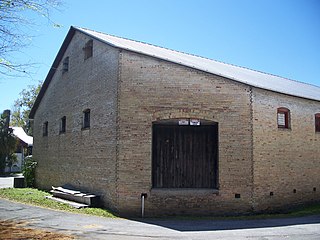
The Baird Hardware Company Warehouse is a historic building in Gainesville, Florida, United States. It is located at 619 South Main Street. On November 25, 1985, it was added to the U.S. National Register of Historic Places.

The Cox Furniture Store c. 1890 is a historic site in Gainesville, Florida, United States. Built in the form and style of a small Romanesque Revival church, it is located at 19 Southeast First Avenue. On June 10, 1994, it was added to the U.S. National Register of Historic Places.

The Cox Furniture Warehouse is a historic site in Gainesville, Florida, United States. It is located at 602 South Main Street. On June 10, 1994, it was added to the U.S. National Register of Historic Places.
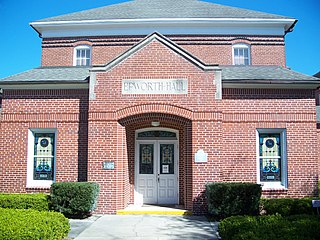
Epworth Hall is a historic building in Gainesville, Florida, United States. It is notable as one of the oldest surviving buildings associated with the University of Florida, though it is no longer part of the university's campus. It was erected in 1884 and is located at 419 Northeast 1st Street in downtown Gainesville. Now part of the First United Methodist Church, it was added to the U.S. National Register of Historic Places on July 25, 1973.

The Old Gainesville Depot is a historic site at 203 Southeast Depot Avenue in Gainesville, Florida. It was added to the U.S. National Register of Historic Places on November 22, 1996. Part of the Depot was built around 1860 to serve the Florida Railroad, which reached Gainesville from Fernandina in 1859. It is one of only three surviving railroad depots in the state built prior to the start of the American Civil War. The depot was situated with tracks on both sides. Between 1892 and 1897, the depot was remodeled to provide two passenger waiting rooms, one for whites and one for Blacks. A new passenger depot with segregated waiting rooms was built in 1910, and the old depot was moved and attached as a freight house to the passenger depot. Depot operations were moved to a new building where East University Avenue crossed the rail line in January, 1948. After the railroad opened the new depot, the old depot building was used by Baird Hardware, Gator Ice and Voyles Appliance store. The City of Gainesville acquired the depot building in 1999.

The John F. Seagle Building is a historic building located at 408 West University Avenue in Gainesville, Florida, in the United States. Built in 1926, it was designed by noted University of Florida architect and professor Rudolph Weaver and built by G. Lloyd Preacher & Company.

Anderson Hall is a historic building located in the northeastern section of the University of Florida campus in Gainesville, Florida. The building houses the university's political science and religion departments, both a part of the College of Liberal Arts and Sciences. Anderson Hall was designed by William Augustus Edwards, responsible for planning nearly all of the campus' early buildings, in Collegiate Gothic style. Construction began in 1912, and the building opened in October 1913 as Language Hall.
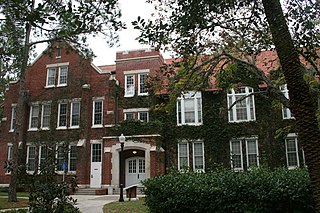
Bryan Hall is a historic building in Gainesville, Florida, United States. It is in the northeastern section of the University of Florida in Gainesville. On June 27, 1979, it was added to the U.S. National Register of Historic Places. Bryan Hall is part of the Warrington College of Business. The building also was home to the College of Law from 1914–1969.

Keene-Flint Hall is a historic site in Gainesville, Florida, United States. It is located in the northeastern section of the University of Florida. On June 27, 1979, it was added to the U.S. National Register of Historic Places. Keene-Flint Hall houses the University of Florida's History Department.
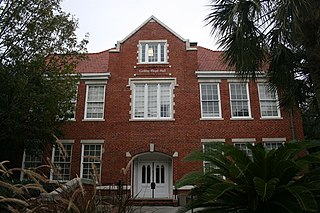
Griffin–Floyd Hall is a historic academic building located on the northeastern portion of the University of Florida campus in Gainesville, Florida. On June 27, 1979, it was added to the U.S. National Register of Historic Places. It currently houses the Department of Philosophy and Department of Statistics.

Newell Hall is a historic site in Gainesville, Florida, United States. It is located in the northeastern section of the University of Florida. On June 27, 1979, it was added to the U.S. National Register of Historic Places. Formerly home to the Department of Soil and Water Science, the building is currently used as a 24/7 study space for university students to collaborate.

Peabody Hall is a historic site in Gainesville, Florida, United States. It is located in the northeastern section of the University of Florida. On June 27, 1979, it was added to the U.S. National Register of Historic Places. It currently houses the Dean of Students Office and the Counseling Center at the university.

Thomas Hall, built in 1905, is a historic building located in Murphree Area on the campus of the University of Florida in Gainesville, Florida, United States. The building is named for William Reuben Thomas, the Gainesville mayor and businessman responsible for bringing the University of Florida to Gainesville.

Norman Hall is an historic academic building on the eastern campus of the University of Florida in Gainesville, Florida. It was designed by architect Rudolph Weaver in the Collegiate Gothic style, and built in 1932. It originally housed the university's research and development primary and secondary schools, but now is the principal building of the university's College of Education. It is located on U.S. 441, near the southwest corner of S.W. 3rd Avenue and S.W. 12th Street in Gainesville. On January 26, 1990, it was added to the U.S. National Register of Historic Places.
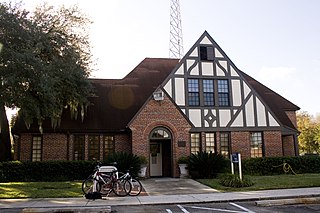
The Old WRUF Radio Station is a historic site in Gainesville, Florida, United States. It is located on the University of Florida campus. On September 21, 1989, it was added to the U.S. National Register of Historic Places.

Alachua County, Florida is home to six state parks. Two of them are also National Natural Landmarks, one is a historic district, one is a National Historic Landmark, and one is a rail trail. Unless otherwise noted, all of the parks adhere to the Florida State Parks schedule; Florida state parks are open between 8 a.m. and sundown every day of the year.

























